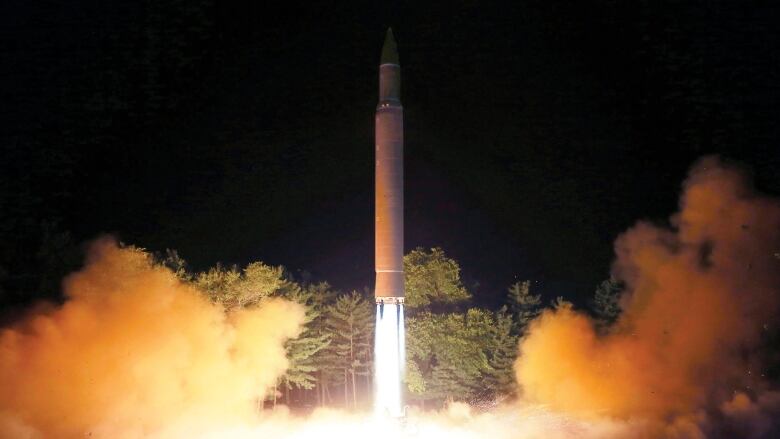Here's what could happen if North Korea detonates a hydrogen bomb
Experts share some of the ramifications to human health, the environment and technology

Razed cities. Loss of life. Contaminated fishing stocks. Crippledsatellite networks.
Shouldthe nuclear crisis between the United States and North Korea escalatebeyondhurling test missiles and insults like "madman"and "dotard,"the list of possible effects is a long and frightening one.
WhetherNorth Korea were to simply test a nuclear warhead or aim one at a target like the U.S. territory of Guamas North Korean leader Kim Jong-un has threatened there wouldbe consequences for both peopleand the environment.
It's impossible to predict preciselythe effects of a North Korean nuclear blast because so much depends on the type, size and method and elevation of the detonation, saysDanny Lam, a Calgary-based defence analyst with a PhD in political science and an M.Sc.in civil and environmental engineering.
But using as a guide the size of the nuclear test North Korea conducted Sept. 3 estimated at 250 kilotonnes some idea of the scope of the damage can be estimated.
"These are not toys," says Lam, who recently testified beforethe House of Commons defence committee convened to discuss North Korean aggression. "These are big massive weapons that generate massive effects. These are big city busters."
- Earthquake in North Korea briefly stokes nuclear fears
- U.S. warns of 'massive military response' following North Korea's 6th nuclear test
North Korean Foreign Minister Ri Yong Hohas said the country will perform an atmospheric test ofa hydrogen bomb over the Pacific Ocean, after claiming a successful underground test of a hydrogen bomb in early September. Hydrogen bombs have a far larger yield than traditional weapons.
But it's not known if the nation has the technology to make abomb small enough to fit on a missile. Its missile testing in the Pacific has sent unarmed missiles into the Earth's atmosphere, but someseemed to have a range that could reach the West Coast of the U.S.
Nuclear fallout zone

In the 1950s, a series of nuclear tests in Bikini Atoll, part of the Pacific's Marshall Islands,were much bigger than North Korea's most recent test. But they rendered the whole area unlivabledue to contaminated soil and waterthat madefarming and fishing dangerous.Eventuallyall residents had to be relocated and they have not returned.
For context, it's important to know that the world has already seen testing of nuclear weapons far biggerthan what North Korea is known to have, says Lam, and it hasn't caused widespread radiation sickness or environmental devastation beyond the blast area.
"If they launched the warhead, we can safely say that it be real bad for any persons nearbybut it is probably not a big deal in terms of radiation release except for the local area."
An atmospheric nuclear test would be far more dangerous than detonations in controlled underground environments,because of the force of the blast and unrestrained release of radioactive materials that could spread out over large areas. Such a launch would potentially endanger aircraft and ships because it's highly unlikely the North would give prior warnings or send naval vessels to the area to control sea traffic.
Lee Choon Geun, a missile expert from South Korea's Science and Technology Policy Institute, says missile tests can easily go wrong, and the consequences of failure could be terrifying if the missile is armed with a nuclear weapon.
If a misfire comes close to Japan, that could trigger retaliation from Washington, he told Reuters.
Electromagnetic pulse
Much more threatening to the broader worldis the potential damagefrom an electromagnetic pulse (EMP) triggered by an atmospheric nuclear blast, says Peter Vincent Pry, executive director of the Task Force on National and Homeland Security in the U.S.
EMPis a burst of electromagnetic energy that destroys or damages satellite networks.
If North Korea was to detonate a certain kind of EMP-emitting bomb at high altitude, the low-earth orbit satellites would be destroyed ordamaged,says Pry. "And they are vital to our ability to defend South Korea; they're vital to our economy."
"Even the GPS systems in automobiles, airplanes depend on these satellites. Our communications, both commercial and military, depend on these satellites," says Pry, who has served on several congressional committees on EMP and other aspects of defense.
That means, not only would your cellphone network bedown at home, militarywho normally performhigh-tech targeted missionswouldn't have the satellite data they rely upon to do so.
Without thosespace systems, the U.S. and its allies would move backward to an industrial-era military forced to counter threats like those from North Korea the old-fashioned way through sheer numbers. "We'd be worse off, because we don't train for that kind of war and they do."
- 'Madman' vs. 'dotard': Trump and Kim Jong-un trade insults, military threats
- End of a special relationship? China looks at North Korea with frustration and even fear
There's a reason that the comprehensive nuclear-test ban treaty forbids this kind of high atmospheretests, says Lam.
"We haven't had this type of horror really since [the Second World War] and we'd much prefer we never see it again."
Corrections
- An earlier version of this story said that defence analyst Danny Lam has a PhD in environmental engineering. In fact, Lam has a PhD in political science and an M.Sc. in civil and environmental engineering.Sep 25, 2017 6:21 AM ET
With files from Reuters












_(720p).jpg)


 OFFICIAL HD MUSIC VIDEO.jpg)
.jpg)



























































































